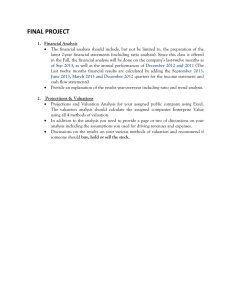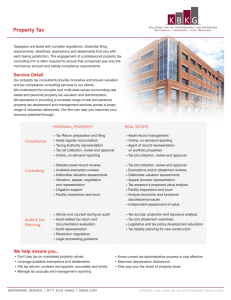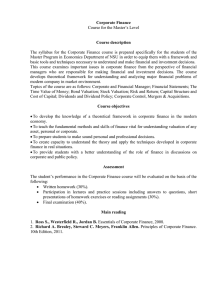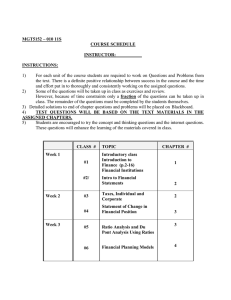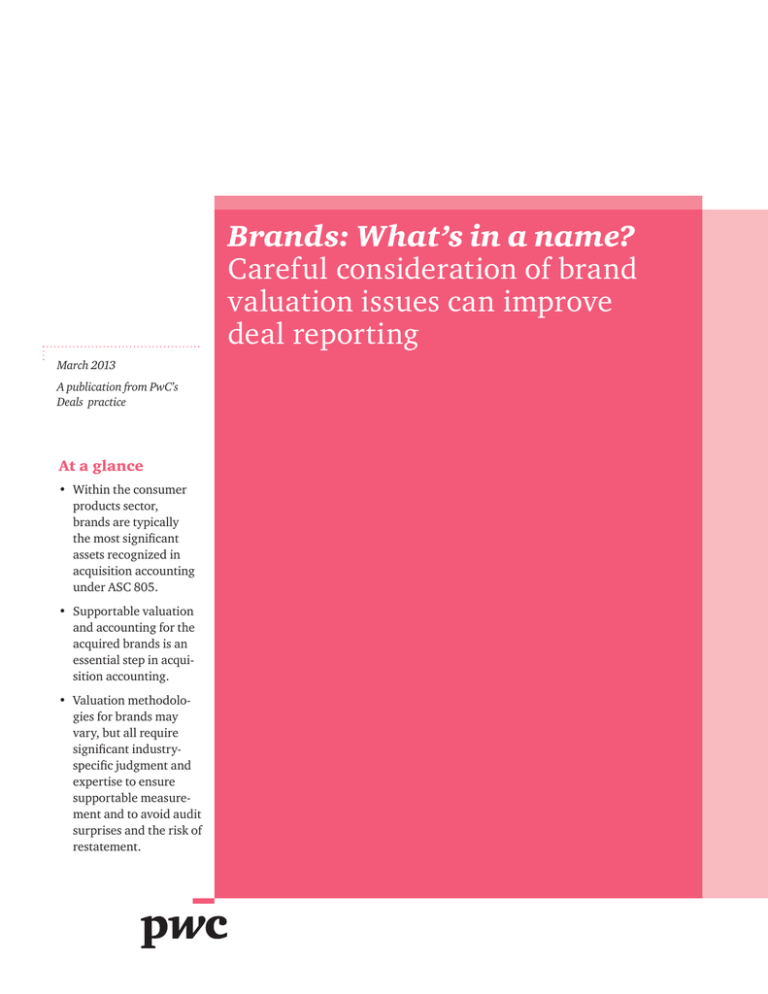
Brands: What’s in a name?
Careful consideration of brand
valuation issues can improve
deal reporting
March 2013
A publication from PwC’s
Deals practice
At a glance
• Within the consumer
products sector,
brands are typically
the most significant
assets recognized in
acquisition accounting
under ASC 805.
• Supportable valuation
and accounting for the
acquired brands is an
essential step in acquisition accounting.
• Valuation methodologies for brands may
vary, but all require
significant industryspecific judgment and
expertise to ensure
supportable measurement and to avoid audit
surprises and the risk of
restatement.
Introduction
For many consumer products companies, M&A transactions are often
driven by the underlying brands. New brands can help fuel global
expansion. On the flip side, brand divestitures can help hone product
portfolio growth and profitability.
However, brand-rich transactions can be fraught with accounting
complexities. The main reason is that the term brand typically
encapsulates multiple components above and beyond just simple
trade names.
Planning brand transactions with a careful eye on the valuation and
purchase accounting issues can provide better insight into the potential
accretive or dilutive impact of a deal, help improve and streamline postdeal accounting and even reduce the risk of impairment in some cases.
Overlooking the complexities can result in unwanted surprises, audit
delays and possibly even increased risk of impairment.
Identifying the issues
Some of the valuation and accounting
issues acquiring companies face in
light of this multifaceted nature of
brands include:
• If an entire company is not acquired,
do the acquired brands constitute
a business under ASC 805 (see
box to the right) or should they be
accounted for as an asset or group
of assets?
• What are the accounting differences
between a business combination
and acquisition of an asset or group
of assets?
Acquisition accounting basics
• How should companies identify
the unit of account for the assets
acquired in a brand purchase?
• What methodologies are
appropriate in valuing acquired
brands, particularly when customer
relationship assets will also
be recognized?
• How will the valuation
methodologies and inputs
impact the assessment of useful
lives, ongoing amortization and
subsequent period earnings?
• How will the initial valuation
assumptions impact ongoing
impairment testing for the
acquired assets?
• How should these valuation and
purchase accounting considerations
impact my due diligence process?
FASB Accounting Standards Codification (ASC)
805 (formerly known as FAS 141R), Business
Combinations, provides the framework for:
• identifying the occurrence and timing of
business combinations;
• accounting for the consideration paid
in connection with the acquisition of a
business; and
• allocating the consideration paid to the
individual assets acquired and liabilities
assumed.
PricewaterhouseCoopers LLP
3
What did I buy?
Purchase accounting first requires
determining whether you acquired a
business or simply an asset or group
of assets. The answer guides how
consideration is treated (as is the
case for earn-outs) and the allocation
method. For example, only a business
combination can give rise to goodwill,
and only in an asset acquisition
can value be recognized for an
assembled workforce.
ASC 805-10-55-4 says that a group
of acquired assets can be considered
a business if the assets form an
integrated set of activities capable of
being conducted and managed for
the purpose of providing a return
to investors or other stakeholders.
These criteria set a fairly low bar
for classifying a transaction as a
business combination.
Potential aspects of a brand
• Trademarks
• Trade names
• Product formulations/recipes
• Marketing materials
• Style guides
• Websites and URLs
• Unique packaging/trade dress
4
Brands: What’s in a name?
For example, assume you acquire
control of a group of assets. If
you could generate a return with
these assets either in isolation or
by combining them with assets
already owned or rented, a business
combination would likely result. The
acquisition accounting guidance under
ASC 805 would apply in this example.
Acquisitions within the consumer
products sector typically involve the
transfer of not only brands, but also
additional assets such as an assembled
workforce and manufacturing
facilities. Therefore, most consumer
products companies are able to
generate a return—either from the
assets acquired in isolation or by
leveraging the acquired assets along
with those assets already owned. Thus,
these types of brand purchases often fit
the criteria of a business combination.
Although uncommon, certain brand
acquisitions may be viewed as asset
purchases rather than business
combinations. If, for example, the
only asset acquired is the rights to the
brand itself, the criteria of a business
combination may not be met. In rare
circumstances, this conclusion could
result even if the acquired rights
included access to not only trade
names and trademarks, but also
product formulations, advertising
materials or other components of what
is typically considered a brand.
Determining what constitutes an asset
beyond the brand can be subjective.
Clearly documenting exactly what
was—and was not—acquired can
help determine whether the business
combination criteria have been met.
Yeah… but what did I
really buy?
there is a single unit of account (i.e., an
all-inclusive brand asset) or multiple
separate units requiring individual
valuations. This unit of account
decision could consider, among other
things, the extent to which these
components have similar remaining
economic lives.
Whether the transaction is accounted
for as an asset purchase or a business
combination, the acquirer must sort
out the various units of account to
select the appropriate valuation
methodologies and assumptions.
When dealing with acquired brands,
this unit of account question can often
be complex.
As an example, consider a company
that determines the long history and
expected perpetual use of the acquired
trademarks would warrant an indefinite
life. At the same time, the ever-changing
nature of the product recipe lends itself
to a finite life. These two components
would need to be separately valued,
amortized (for the finite-lived asset)
and monitored for impairment.
The complexity arises from the fact
that brands in the consumer products
sector typically include a range of
components (see callout on page 4).
More than one of these elements may
be present in the purchase. Therefore,
acquirers should determine whether
In this context, acquirers should
also distinguish between various
types of brands within the acquired
business. For example, when
determining whether aggregation or
disaggregation of assets is appropriate,
an overarching corporate brand
may have a different useful life and
require different treatment when
compared to a product-level brand.
The latter is more likely to be heavily
tied to specific recipes, marketing, etc.
These aggregation decisions could
have a sizeable impact on ongoing
amortization and, therefore, net
income.
Intangible assets arising from consumer products acquisitions
Acquired business
Tangible assets
Marketing related
Identifiable intangibles
Customer related
• Trademarks
• Distributor relationships
• Trade names
• Retailer relationships
• Marketing materials
• Order or production
backlog
• Style guide (unique color,
shape or package design)
• Mastheads
• Contractual and
non-contractual
customer relationships
• Domain names
Other balance sheet items
Technology related
Contract related
• Trade secrets, such as
secret formulas, processes
or recipes
• Supply contracts
• Patented and un-patented
technology
• Licensing and
royalty agreements
• Computer software
• Lease agreements
• Databases
• Construction permits
• Advertising, management
and service contracts
• Franchise agreements
• Non-competition
agreements
Primary intangible assets for consumer product acquisitions
PricewaterhouseCoopers LLP
5
Valuation methods
The methodologies used to value an
acquired brand will ultimately depend
upon the components determined to be
included within its unit of account. The
two most common models for valuing
marketing-related intangibles such as
brands are:
1. the Excess Earnings method and
2. the Relief-from-Royalty method.
These two methods are forms of the
Income Approach, in which value is
equated to a series of cash flows and
discounted at an appropriate riskadjusted rate. The Excess Earnings
method calculates the value of an asset
based on the expected revenue and
profits related to that asset, less the
portion of those profits attributable
to other assets that contribute to the
generation of cash flow (e.g., working
capital, fixed assets, assembled
workforce, etc.). The Relief-fromRoyalty method, on the other hand,
is based on a hypothetical royalty
(typically calculated as a percentage
of forecasted revenue) that the owner
would otherwise be willing to pay to
use the asset—assuming it were not
already owned.
In theory, the two methods should
arrive at the same value. However,
valuation specialists will typically
reserve the Excess Earnings method
for intangible assets deemed to be the
primary driver of profits. The Relieffrom-Royalty method is often used
for intangible assets deemed to be of
secondary significance.
6
Brands: What’s in a name?
In the consumer products sector,
determining the “primary” acquired
asset can be challenging. Both
marketing-related intangibles (such
as trademarks and trade names) and
customer-related intangibles (such as
distributor relationships and retailer
relationships) can play key roles in
driving product sales.
The Excess Earnings method and
the Relief-from-Royalty method
can, at times, result in different
values. Therefore, the selection of
the appropriate methodology can
have a meaningful impact on the
ultimate valuation and ongoing
amortization expense.
To that end, an in-depth understanding
of the landscape in which the brand
competes and the key revenue drivers
is needed to select an appropriate
valuation methodology for each
acquired asset. Additionally, because
the two valuation methodologies
have different inputs, the disclosure
requirements can differ as well,
something appraisers and filers need to
consider when selecting an approach.
Analyzing the promotional strategy
of the acquired business is one way
to determine the most appropriate
methodology for acquired assets. As
an example, brands themselves are
often deemed to be the primary asset
for “pull” market products—which
distributors and retailers often feel
pressured to carry because of highend customer demand. On the other
hand, customer relationships are often
primary for “push” market products for
which significant promotional effort
is usually required to gain shelf-space
with distributors and retailers.
These distinctions are not always easy
to make. However, an all-inclusive
brand asset that encapsulates all
of the components mentioned
previously (trademarks, trade names,
formulations, style guides, etc.)
is more likely to be considered a
primary asset than any one of those
components individually.
Although outside the scope of this
publication, various alternative
methodologies may be appropriate
in specific circumstances. Examples
include methods that calculate the
cost associated with recreating these
relationships or another that utilizes
the profit margin one would expect
from a limited-risk distributor of
the product.
Examples of brand-rich transactions
Acquirer
Brand
Seller
Kellogg
Pringles
Proctor &
Gamble
Fila
Titleist
Fortune
General Mills
Yoplait
n/a*
Tempur-Pedic
Sealy
n/a*
For illustrative purposes only
*Complete company acquisition
Application of the Excess
Earnings method
As noted previously, the Excess
Earnings method values an asset
based on expected future income,
adjusted for the returns of other
assets contributing to cash flow (i.e.,
“contributory assets”). When the brand
is the primary asset and the Excess
Earnings method is used to determine
its value, careful consideration
should be given to how the acquired
company’s customer relationships help
contribute to the sales process and the
manner in which a return for these
relationships should be reflected in
the valuation of the brand.
The Excess Earnings method cannot
be used to value both brands and
relationships due to the doublecounting of cash flow. Therefore,
an alternative method should be
applied to value these relationships.
These alternative approaches
might lower the value of customer
relationships when compared to the
Excess Earnings method. Reason:
These relationships are deemed to be
of secondary importance relative to
the brands.
A word on the Relief-fromRoyalty method
All valuation methodologies require
some level of subjectivity and
judgement. However, the prevalence
of the Relief-from-Royalty method
and its perceived simplicity in valuing
marketing-related intangibles often
gives rise to some common pitfalls.
As mentioned previously, the Relieffrom-Royalty method involves
forecasting the asset’s revenue stream
and an assumed royalty rate that a
hypothetical third-party would be
willing to pay for use of the asset. The
latter input can often lead to a number
of complications.
Specifically, in making their rate
selection, most practitioners will look
to rates paid in arms-length licensing
transactions for assets comparable
to the one being valued. Although
this method of selection may sound
straightforward, determining what
constitutes comparability can be
quite complex.
Practitioners should consider the
comparability of the following factors,
among others, when analyzing royalty
rates observed in the market:
• Assets. For example, a royalty rate
paid for a trademark in isolation
would likely be lower than one for a
bundled asset including trademarks
and product formulations.
• Rights (e.g., geography, term and
usage). All things being equal, a
royalty rate paid for the right to use
an intangible asset within a limited
geography or specific customer
channel for a limited time would
likely be different than that paid
for perpetual rights with unfettered
usage. Similarly, consider the rights
to use a trademark or trade name
associated with a specific type of
product. Usage rights in a unique
context (e.g. the right to use a
trademark associated with a popular
brand of candy on a line of apparel)
would not be truly comparable
to using it within its own normal
context (e.g. using the candy
trademark on a candy product).
• Economic returns. Typically,
assets providing higher returns
will warrant higher royalty
rates. This issue may arise when
comparing royalty rates paid at
different points in the supply chain.
Returns on wholesale revenues can
differ significantly from those on
retail revenues.
PricewaterhouseCoopers LLP
7
The use of simplified rules of thumb may lead to
inappropriate conclusions and create significant
hurdles during an audit or regulatory review.
• Upfront fees or ongoing cost
sharing. Licensees who are willing
to pay an upfront fee or share in
future marketing or advertising
expenses may be able to negotiate a
lower royalty rate.
but the same company or another in
the industry earns only 12% on the
sale of otherwise substantially similar
unbranded products. The difference of
8% could be viewed as the incremental
profit associated with the brand.
These issues are just a sampling
of those required to properly
identify and analyze comparable
licensing transactions.
As an alternative analysis, start with
the overall operating profit margin of
the business and subtract returns for
activities not specifically related to the
brand. Such activities may include the
manufacturing, selling and distribution
functions, among others.
The use of comparable agreements is
one source of royalty rate information,
but a number of alternative approaches
also exist. One popular technique,
often referred to as the Profit Split
method, attempts to isolate the
proportion of a company’s profit
margin that can be specifically
attributed to the brand itself.
Valuation practitioners often use
a number of “rules of thumb” to
determine this proportion, but these
shortcuts do not typically stand up well
to scrutiny by auditors and regulators.
Rather, acquirers should consider more
case-specific information in making
these determinations.
Comparing profit margins for branded
products relative to generic, or
unbranded, products is one way to
determine the profit associated with
a brand. For example, consider a
company that earns an operating profit
of 20% on its branded product sales
8
Brands: What’s in a name?
Representative returns for these
non-brand functions can be gleaned
from margins earned by outsourcing
companies that perform these
functions in isolation. Once the returns
for these functions are subtracted
from the overall profit margin, the
remaining profit can be viewed as
a proxy for the incremental margin
attributable to the brand itself. The
result can form the basis for selecting a
royalty rate.
Selecting an appropriate royalty rate
for use in the Relief-from-Royalty
method can be complex and requires
significant valuation and industryspecific judgment and support. While
common in practice, the use of broadly
comparable licensing transactions or
simplified rules of thumb may lead to
inappropriate conclusions and create
significant hurdles during an audit or
regulatory review.
Alternative valuation
approaches
Income-based methodologies are
most prevalent in the valuation
of marketing-related intangibles.
However, certain aspects of a brand’s
value can, at times, be estimated with
alternative approaches.
A Cost Approach may be most common
for brand components that can be
readily reproduced, such as product
formulations. Even trade names can, in
certain rare instances, be valued with
such an approach if they were recently
launched and have not yet been
established in the marketplace. Again,
the distinction between “push” and
“pull” marketing may help guide the
decision as to whether a Cost Approach
is appropriate, as the cost to replicate a
name or mark is a more relevant metric
for “push” marketed products.
Although extremely rare, a Market
Approach can be considered to value
the components of a brand that have
an active market. In each instance,
acquirers should carefully consider the
facts and circumstances surrounding
the transaction at hand.
A note on
defensive assets
Defensive assets are generally
intangible assets that an entity
does not intend to use, but whose
economic returns will be derived
by withholding the asset from
the market. A common example
in the consumer products sector
would involve the acquisition and
retirement of a competing brand in
an attempt to increase market share
of the acquirer’s existing product.
The valuation and selection of an
appropriate amortization period
for defensive assets can be highly
challenging.
As a general rule, the valuation
assumptions should be based on
the manner in which a market
participant would expect to generate
returns from the asset. These
assumptions can vary significantly
depending on whether other market
participants would also use the asset
strictly for defensive purposes.
For example, if market participants
would be expected to use an asset
in a more traditional, non-defensive
manner, the valuation should
reflect this use and would likely
take the form of a more typical
asset valuation. But what if market
participants similarly used the asset
for its defensive purposes only or
discontinued the brand outright?
Then, the valuation should reflect
only those economic benefits
associated with this form of use
(i.e. increased market share,
ability to increase prices, etc.).
Identifying market participants,
determining expected asset use
and quantifying defensive use
benefits all require substantial
industry expertise and judgment.
Valuation should be performed
from a market participant
perspective, but amortization
should be based on the buyer’s
expected use of the asset. As a
result, the life of the cash flows
used to value the asset may be
unrelated to the amortization
period assigned to it.
Specifically, the acquirer should
consider the period over which
economic benefits from its
defensive use of the asset are
derived. Generally, defensive
assets are not expected to diminish
in value immediately, but over a
period of time due to the lack of
support for the asset (e.g. lack of
advertising and marketing efforts
to maintain the asset, etc.). To that
end, defensive assets are rarely
assigned an indefinite life.
PricewaterhouseCoopers LLP
9
Useful lives and
amortization
Economic and useful lives are key
inputs into both the valuation
and subsequent impact to
income of acquired assets. Key
considerations include:
• The period over which the asset
is expected to be used and to
contribute to cash flow
• Any legal, regulatory or contractual
provisions that may limit the
useful life
• Historical experience in the use of
similar acquired assets
• The impact of anticipated changes
in consumer demand and tastes
as well as other economic and
industry trends
• The level of expenditures (including
ongoing marketing and advertising)
required to maintain the asset
• The life of other related assets
Furthermore, acquirers should
consider whether any of the
acquired assets qualify for indefinitelived treatment under ASC 350,
Intangibles—Goodwill and Other.
Having no foreseeable limit to the
period over which the asset is expected
to contribute to the entity’s cash flows
Acquirers should exercise as much foresight as
possible at the initial measurement date to set
a robust framework for impairment testing in
future periods.
10
Brands: What’s in a name?
is the key criterion for such classification. Well-known brands within the
consumer products sector often meet
this hurdle, as companies usually
expect to continue supporting these
assets with ongoing marketing efforts.
The factors that impact the
amortization period of an asset
are similar to those that should
be considered in determining the
economic life of the cash flows used
to value that asset. For that reason,
companies will typically look to the
period over which the cash flows used
in the assets’ valuations are forecast
to select an appropriate amortization
period or indefinite-life classification.
Reconciliation (but not necessarily
equivalence) between the valuation
forecast term and the amortization
period is often required in the eyes of
auditors and regulators. The selection
of the appropriate amortization
period can play a large role in postdeal dilution. Therefore, acquirers
and valuation specialists should
strongly consider the interplay
between the valuation assumptions
and the resulting impact on ongoing
net income.
Impairment testing
Supportable initial valuations and the
selection of appropriate amortization
periods (or determination of an
indefinite life) are critical not only for
post-deal dilution analysis, but also
for ongoing impairment testing. The
initial assumptions and methodologies
used to value an asset in purchase
accounting typically form the basis
for how that asset is assessed for
impairment in later periods. To that
end, acquirers should exercise as much
foresight as possible at the initial
measurement date to set a robust
framework for impairment testing in
future periods.
With regard to the useful life determination, the impairment test for
indefinite-lived assets differs significantly from that of finite-lived assets.
Specifically, indefinite-lived assets are
usually tested for impairment under
ASC 350 on an asset-by-asset basis,
whereas finite-lived assets are only
tested for recoverability (a significantly
lower hurdle to overcome than the
fair value test for indefinite-lived
assets) under ASC 360. They are often
grouped together with other assets into
an asset group for testing purposes,
potentially providing additional
protection from impairment.
As a result of these differences, brands
assigned a long (but finite) life are
typically less prone to impairments
than those assigned indefinite lives.
Furthermore, indefinite-lived assets
must be tested at least annually for
impairment. Finite-lived assets are
only tested upon the occurrence of
a “triggering event”. To that end,
testing finite-lived assets is typically
less burdensome.
It is also worthwhile to note that
the valuation considerations noted
above regarding selection of the
appropriate valuation methodology
and assumptions also come into play
when determining the fair value
of brand-related assets within the
impairment context.
How does this impact
pre-deal diligence?
To structure and communicate acquisitions effectively, companies
must understand the impact of
purchase accounting on the newly
merged company’s earnings. A focus
on more robust pre-acquisition
valuation helps mitigate the risk
of purchase accounting estimates
being significantly different from
what is ultimately recorded at
transaction close.
This is more important than ever as
a result of the new accounting standards increasing the potential for
post-close earnings volatility. Companies will be better positioned to
assess the accretive or dilutive impact
of a transaction if an effective preacquisition valuation is performed
during the due diligence phase.
Thoroughly thinking through the
valuation and purchase accounting
issues during the due diligence phase
of a deal provides a number of benefits:
• Better insight during due diligence
on the accretive/dilutive impact
to EPS and financial reporting
considerations for the proposed
transaction
Conclusion
Acquisitions in the consumer products
sector give rise to a number of
valuation and accounting issues that
require strong familiarity with the
technical accounting guidance as well
as deep industry experience. A number
of these complications arise as a result
of the large role that multifaceted
brands play within the industry.
Classification of the transaction
as a business combination or asset
acquisition, determination of the unit
of account for the acquired assets
and the assignment of useful lives all
necessitate a deep understanding of
the applicable accounting guidance.
The identification of market
participants and the selection of
appropriate valuation methodologies
and assumptions require substantial
technical valuation and industry
expertise. The combination of these
two skill sets will allow for better
planning for post-deal dilution, a more
streamlined review by auditors and
regulators, and a robust framework
when considering the possibility of any
future impairments.
• Greater efficiency resulting from
more up-front valuation analysis
that can be more easily converted to
a post-transaction valuation
• Improved communication with
stakeholders to help set the right
expectations upfront and avoid
future surprises
PricewaterhouseCoopers LLP
11
www.pwc.com/us/deals
To have a deeper conversation
about how this subject may
affect your business, please
contact one of our retail &
consumer specialists:
For a deeper discussion on
deal considerations, please
contact one of our regional
leaders or your local
PwC partner:
Andrew Pappania
Principal, Deals
Valuation Services
(646) 471 0538
andrew.pappania@us.pwc.com
Martyn Curragh
Partner, US Deals Leader
(646) 471 2622
martyn.curragh@us.pwc.com
Reto Micheluzzi
Partner, Deals
Accounting Advisory Services
(415) 498 7511
reto.micheluzzi@us.pwc.com
Reuven Pinsky
Director, Deals
Valuation Services
(646) 471 8231
reuven.pinsky@us.pwc.com
Gary Tillett
Partner, Deals
New York Metro Region Leader
(646) 471 2600
gary.tillett@us.pwc.com
Scott Snyder
Partner, Deals
East Region Leader
(267) 330 2250
scott.snyder@us.pwc.com
Mel Niemeyer
Partner, Deals
Central Region Leader
(312) 298 4500
mel.niemeyer@us.pwc.com
Mark Ross
Partner, Deals
West Region Leader
(415) 498 5265
mark.ross@us.pwc.com
PwC provides tactical and strategic thinking on a wide range of issues that affect the deal community.
Visit us atwww.pwc.com/us/deals to download our most current publications.
© 2013 PricewaterhouseCoopers LLP, a Delaware limited liability partnership. All rights reserved. PwC refers to the US member firm, and may sometimes refer to the
PwC network. Each member firm is a separate legal entity. Please see www.pwc.com/structure for further details.
This content is for general information purposes only, and should not be used as a substitute for consultation with professional advisors. PwC US helps organizations
and individuals create the value they’re looking for. We’re a member of the PwC network of firms with 169,000 people in more than 158 countries. We’re committed to
delivering quality in assurance, tax and advisory services. Tell us what matters to you and find out more by visiting us at www.pwc.com/us. AT-13-0182


